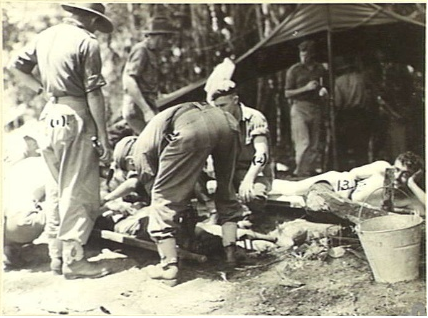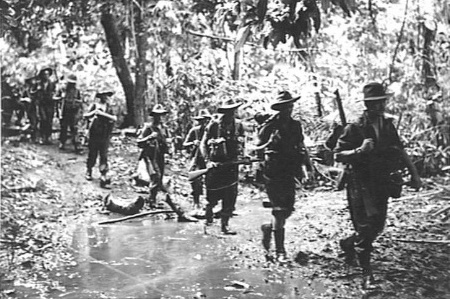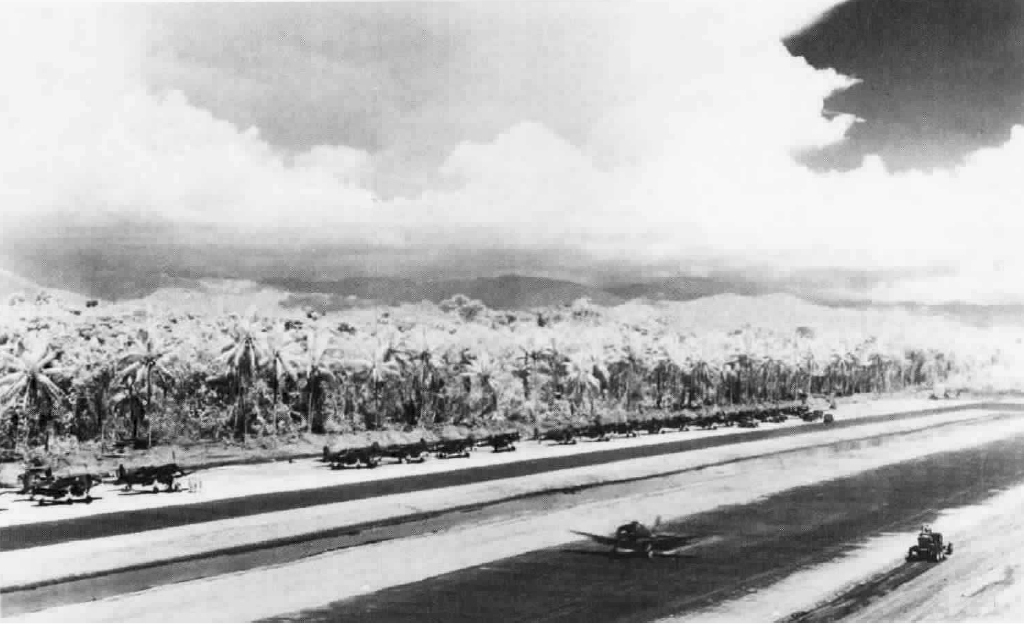|
Battle Of Tsimba Ridge
The Battle of Tsimba Ridge was an engagement of the Second World War involving Australian and Japanese forces. Part of the wider Bougainville Campaign of the Pacific theatre, the battle occurred in the northern sector of Bougainville Island between 17 January and 9 February 1945, when the lead battalion of the Australian 11th Brigade—the 31st/51st Infantry Battalion—advanced towards the Genga River as part of a drive north to the Bonis Peninsula. On the peninsula, an enclave of Japanese troops had established itself after withdrawing north following earlier engagements in the centre of the island throughout 1944–45. Coming up against heavy resistance along Tsimba Ridge, the Australians' advance was halted for three weeks as they fought to wrest control of the ridge from the defending Japanese from the 81st Infantry Regiment, whose strength was roughly equal to that of the Australians. The main Australian attack took place on 6 February, but it was not until 9 February ... [...More Info...] [...Related Items...] OR: [Wikipedia] [Google] [Baidu] |
Bougainville Campaign
The Bougainville campaign was a series of land and naval battles of the Pacific campaign of World War II between Allied forces and the Empire of Japan, named after the island of Bougainville. It was part of Operation Cartwheel, the Allied grand strategy in the South Pacific. The campaign took place in the Northern Solomons in two phases. The first phase, in which American troops landed and held the perimeter around the beachhead at Torokina, lasted from November 1943 through November 1944. The second phase, in which primarily Australian troops went on the offensive, mopping up pockets of starving, isolated but still-determined Japanese, lasted from November 1944 until August 1945, when the last Japanese soldiers on the island surrendered. Operations during the final phase of the campaign saw the Australian forces advance north towards the Bonis Peninsula and south towards the main Japanese stronghold around Buin, although the war ended before these two enclaves were comp ... [...More Info...] [...Related Items...] OR: [Wikipedia] [Google] [Baidu] |
Solomon Islands
Solomon Islands is an island country consisting of six major islands and over 900 smaller islands in Oceania, to the east of Papua New Guinea and north-west of Vanuatu. It has a land area of , and a population of approx. 700,000. Its capital, Honiara, is located on the largest island, Guadalcanal. The country takes its name from the wider area of the Solomon Islands (archipelago), which is a collection of Melanesian islands that also includes the Autonomous Region of Bougainville (currently a part of Papua New Guinea), but excludes the Santa Cruz Islands. The islands have been settled since at least some time between 30,000 and 28,800 BCE, with later waves of migrants, notably the Lapita people, mixing and producing the modern indigenous Solomon Islanders population. In 1568, the Spanish navigator Álvaro de Mendaña was the first European to visit them. Though not named by Mendaña, it is believed that the islands were called ''"the Solomons"'' by those who later receiv ... [...More Info...] [...Related Items...] OR: [Wikipedia] [Google] [Baidu] |
Counter-attack
A counterattack is a tactic employed in response to an attack, with the term originating in "Military exercise, war games". The general objective is to negate or thwart the advantage gained by the enemy during attack, while the specific objectives typically seek to regain lost ground or destroy the attacking enemy (this may take the form of an opposing sports team or Military organization#Commands.2C formations.2C and units, military units). A saying, attributed to Napoleon I of France, Napoleon Bonaparte illustrate the tactical importance of the counterattack : "the greatest danger occurs at the moment of victory". In the same spirit, in his Battle Studies, Ardant du Picq, Ardant du Pic noticed that "he, general or mere captain, who employs every one in the storming of a position can be sure of seeing it retaken by an organised counter-attack of four men and a corporal". A counterattack is a military tactic that occurs when one side successfully defends off the enemy’s atta ... [...More Info...] [...Related Items...] OR: [Wikipedia] [Google] [Baidu] |
Battle Of Pearl Ridge
The Battle of Pearl Ridge (30–31 December 1944) was an engagement of the Second World War fought between Australian and Japanese forces on Bougainville Island. Part of the wider Bougainville Campaign, the battle took place in the central sector of the island, shortly after the Australians had taken over responsibility from the Americans. Believing that the ridge was held by less than a company of Japanese, on 30 December the Australian 25th Infantry Battalion launched a four-pronged attacked the ridge. The defending force, however, had been greatly reinforced by elements of the 38th Independent Mixed Brigade and was closer to a battalion in strength. After being held up on the right of their advance, the Australians dug in overnight and repulsed a strong Japanese counterattack before resuming the attack on 31 December. By late in the afternoon, the Japanese had been swept off the ridge. The Australians later established an observation post on the ridge, which had commandi ... [...More Info...] [...Related Items...] OR: [Wikipedia] [Google] [Baidu] |
Philippines Campaign (1944-45)
Philippines campaign may refer to various military campaigns that have been fought in the Philippine Islands, including: Spanish colonial period (1565–1898) *Numerous revolts against Spain during the Spanish colonial period; see Philippine revolts against Spain and Military history of the Philippines#Spanish colonial period (1565–1898) *Various actions fought in the Philippines during the Eighty Years' War between Spain and the Netherlands; see "Eighty Years War (1568–1648)" at Military history of the Philippines#Spanish colonial period (1565–1898) *The Limahong Campaign (1573–1575), an attempt by the Chinese pirate Limahong to seize northern Luzon from Spanish authorities *Various actions fought in the Philippines during the Seven Years War (1756–1763) between European powers; see Military history of the Philippines#Spanish colonial period (1565–1898) and Seven Years' War#Other Continents *The Philippine Revolution (1896–1898), called the "Tagalog Revolt" by th ... [...More Info...] [...Related Items...] OR: [Wikipedia] [Google] [Baidu] |
XIV Corps (United States)
XIV Corps was a corps-sized formation of the United States Army, originally constituted on 1 October 1933 in the Organized Reserves. The history of XIV Corps in World War II dates from December 1942. Then, under Major General Alexander Patch, the XIV Army Corps directed the American 23rd Infantry Division and 25th Infantry Divisions, the 2nd Marine Division, and the 147th Infantry Regimental Combat Team in the final drive that expelled the Japanese from Guadalcanal early in February 1943. The 70th Coast Artillery Regiment (Anti-Aircraft) landed on 23 May 1943. From air fields guarded by the XIV Army Corps, Allied aircraft began the neutralization of the enemy's vital Munda airfields on New Georgia. Major General Oscar Griswold succeeded Patch as XIV Corps commander on 26 April 1943. In a lightning campaign, which began 30 June 1943 with the invasion of Rendova Islands, General Griswold's forces, which included the 43rd (New England) and the 37th (Buckeye) Infantry Divisio ... [...More Info...] [...Related Items...] OR: [Wikipedia] [Google] [Baidu] |
Stanley Savige
Lieutenant General Sir Stanley George Savige, (26 June 1890 – 15 May 1954) was an Australian Army soldier and officer who served in the First World War and Second World War. In March 1915, after the outbreak of the First World War, Savige enlisted in the First Australian Imperial Force. He served in the ranks during the Gallipoli Campaign, and received a commission. He later served on the Western Front, where he was twice recommended for the Military Cross for bravery. In 1918, he joined Dunsterforce and served in the Caucasus Campaign, during which he was instrumental in protecting thousands of Assyrian refugees. He subsequently wrote a book, ''Stalky's Forlorn Hope'', about his experiences. After the war he played a key role in the establishment of Legacy Australia, the war widows and orphans benefit fund. During the early years of the Second World War, Savige commanded the 17th Infantry Brigade in the North African Campaign, the Battle of Greece and Syria–Leban ... [...More Info...] [...Related Items...] OR: [Wikipedia] [Google] [Baidu] |
3rd Division (Australia)
The 3rd Division was an infantry division of the Australian Army. Existing during various periods between 1916 and 1991, it is considered the "longest serving Australian Army division". It was first formed during World War I, as an infantry division of the Australian Imperial Force and saw service on the Western Front in France and Belgium. During this time it fought major battles at Messines, Broodseinde Ridge, Passchendaele, Amiens, and the St Quentin Canal. After the war the division was demobilised in 1919 before being re-raised in 1921 as part of the Citizen Forces, based in central Victoria. Throughout the 1920s and 1930s, the division's establishment fluctuated due to the effects of the Great Depression and a general apathy towards military matters. During World War II, the division was mobilised for war in December 1941 and initially undertook defensive duties in Australia before being deployed to New Guinea in 1943 where they took part in the Salamaua–Lae campa ... [...More Info...] [...Related Items...] OR: [Wikipedia] [Google] [Baidu] |
Australian Army Reserve
The Australian Army Reserve is a collective name given to the reserve units of the Australian Army. Since the Federation of Australia in 1901, the reserve military force has been known by many names, including the Citizens Forces, the Citizen Military Forces, the Militia and, unofficially, the Australian Military Forces. In 1980, however, the current name—Australian Army Reserve—was officially adopted, and it now consists of a number of components based around the level of commitment and training obligation that its members are required to meet. Overview For the first half of the 20th century, due to a widespread distrust of permanent military forces in Australia, the reserve military forces were the primary focus of Australian military planning.Grey 2008, pp. 66–83. Following the end of World War II, however, this focus gradually shifted due to the changing strategic environment, and the requirement for a higher readiness force available to support collective security g ... [...More Info...] [...Related Items...] OR: [Wikipedia] [Google] [Baidu] |
II Corps (Australia)
II Corps was an Australian Army corps, one of three that were raised by the Army during the Second World War. Formed in mid-1942 as part of defensive measures to protect the eastern coast of Australia from invasion, the corps was initially composed mainly of home defence troops drawn from the Militia. For a brief period in 1942, a US infantry division was also assigned to the corps prior to its dispatch to fight the Japanese in New Guinea. After the threat of invasion passed, the corps took more of an operational role and from late 1943 until the end of the war it commanded a mix of Second Australian Imperial Force and Militia units in action against the Japanese in New Guinea and on Bougainville. Following the conclusion of hostilities, the corps headquarters was disbanded in September 1945, and its constituent units transferred to the 3rd Infantry Division. History II Corps headquarters was established at Parramatta, New South Wales, in mid-April 1942 from the previously exis ... [...More Info...] [...Related Items...] OR: [Wikipedia] [Google] [Baidu] |
Bougainville Counterattack
The Bougainville counterattack (also known as the Second Battle of TorokinaShindo (2016), p. 62.) was an unsuccessful Japanese offensive against the Allied base at Cape Torokina, on Bougainville Island, during the Pacific War of World War II. The Japanese attack began on 8 March 1944 after months of preparation, and was repulsed by United States Army forces in fighting which lasted until 25 March. The attack was hampered by inaccurate intelligence and poor planning and was defeated by the well-prepared Allied defenders, who greatly outnumbered the Japanese force. The Japanese suffered severe casualties, while Allied losses were light. The goal of the offensive was to destroy the Allied beachhead, which accommodated three strategically important airfields. The Japanese wrongly believed that their forces were about as large as the units deployed to defend the Allied positions. The Allies detected Japanese preparations for the attack shortly after they began in early 1944 ... [...More Info...] [...Related Items...] OR: [Wikipedia] [Google] [Baidu] |
Empress Augusta Bay
Empress Augusta Bay is a bay on the western side of the island of Bougainville Island, within the Autonomous Region of Bougainville in northeastern Papua New Guinea. It is a subsistence fishing area for the people of Bougainville. History Empress Augusta Bay is named after Augusta Viktoria of Schleswig-Holstein, wife of German Emperor William II. In November 1943 the bay was the site of the Battle of Empress Augusta Bay, between Allied and Japanese forces. During the 1970s and 1980s the bay was seriously polluted by copper tailings from the world's largest copper mine, Panguna, operated by Rio Tinto Group. This issue contributed to the formation of the secessionist Bougainville Revolutionary Army and a civil war A civil war or intrastate war is a war between organized groups within the same state (or country). The aim of one side may be to take control of the country or a region, to achieve independence for a region, or to change government policies ... on the islan ... [...More Info...] [...Related Items...] OR: [Wikipedia] [Google] [Baidu] |



.jpg)


